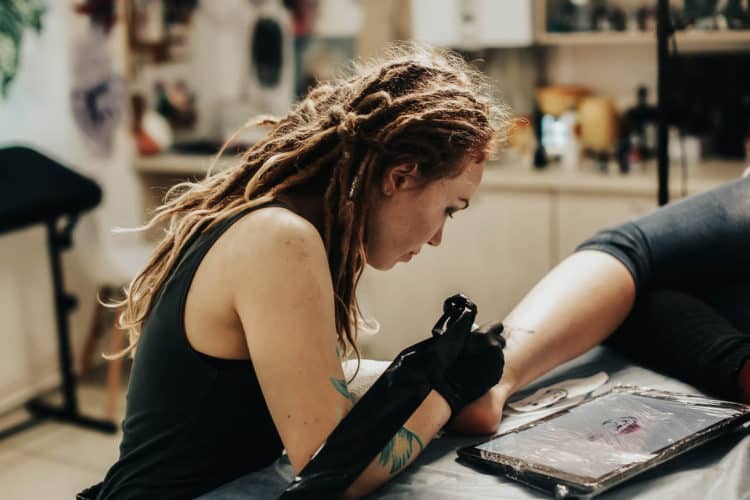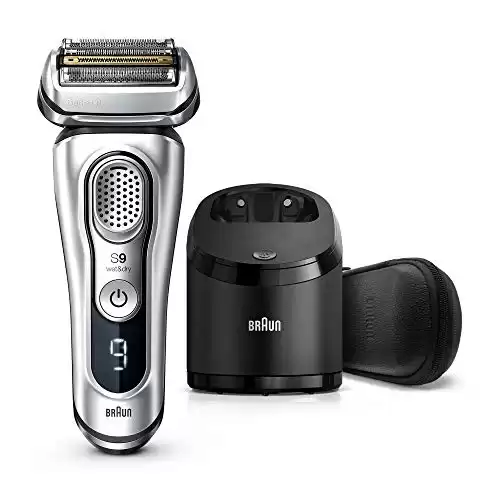When you go to the tattoo parlor to get some fresh ink, your artist will shave the area to get a clean working surface.
Although you could do this work at home, most artists prefer to do it at their shop. That way, they can control the process more efficiently.
Hair regrowth occurs in a day or two for most people. It becomes ingrown if it gets trapped under the skin’s surface instead of growing as it normally would.
That issue can lead to redness and swelling. It might even look like a whitehead pimple appears on your tattoo.
What to Do with Ingrown Hair on Tattoos?
The best way to deal with ingrown hairs on a new tattoo is to let the area heal naturally. Creating a fresh wound on top of the ink leads to increased infection risk. An ingrown hair, acne, or similar raised spots will not impact the tattoo’s quality or the time it takes to heal.
Ingrown hairs inflame the follicle to create irritation and swelling. This issue causes red bumps to form on the skin where they occur. White blood cells flood to the area to initiate the healing process, leading to white spots that look like acne forming in the inked area.
Although ingrown hair can be itchy, uncomfortable, or painful, it is not usually serious. The only worry would be the start of an infection, but that outcome is infrequent if you leave the spot alone.
It’s also rare for the ingrown hair to affect the skin layer that received the tattoo. That means you don’t need to worry about the condition affecting the artwork. Allowing the body to heal naturally won’t compromise the investment you’ve made.
Tattoos don’t interfere or damage any follicles in the area. If you’ve had razor bumps from shaving before, the outcome is similar after getting work done because the hair was cut to fall beneath the skin’s surface.
The only way an ingrown hair could be problematic is if you keep scratching or squeezing the area while scabs start forming. That extra activity can lead to potential infection, scarring, and other unwanted symptoms.
What Causes an Ingrown Hair to Form on a Tattoo?
Ingrown hairs occur when its sharp tip curls back or starts growing sideways into the follicle’s skin. This condition is benign.
It typically causes a pink or tan bump to start forming under the skin. You can sometimes see the hair’s tip in the swelling that happens when the body reacts to the sharp end going somewhere it’s not supposed to be.
People with coarse hair tend to experience this issue more than others. Anyone with curly hair on the arms or legs can also have a higher risk of ingrown hair after shaving an area for a new tattoo.
When you look for information about ingrown hairs online, some information can seem scary when one appears on a tattoo. Here’s an example of this issue from MedicineNet.
“An ingrown hair is medically harmless, yet it may become cosmetically disfiguring and lead to scarring, skin discoloration (referred to as post-inflammatory hyperpigmentation), skin infection, and rarely, keloid scar formation.”
The primary reason ingrown hair forms on a tattoo is that the hair was cut close to or below its follicle opening. When it starts regrowing, it doesn’t come through the area as intended. Although improper shaving techniques can cause this, anything that removes hair can create this issue.
People who get waxed before having a tattoo can still experience ingrown hair.
It’s also possible to experience ingrown hairs by wearing clothing that is too tight. The friction causes the hair to shift where it grows through the follicular opening to cause swelling and redness.
Almost everyone experiences ingrown hair at some point in their lives. It happens to teens and adults more, especially for those with tightly curling hairs.
That means it’s not the tattoo that caused the issue. An ingrown hair is not a sign that an allergy is developing or that an infection started. It’s merely a lousy shave.
How to Prevent Ingrown Hairs from Forming in a New Tattoo
Tattoo artists might shave people daily, but that doesn’t make them professional barbers. The only way to prevent ingrown hairs from forming in some new ink is to use the correct shaving technique for that body area.
Here are the steps you can follow to minimize the risk factors for having this issue develop. You might reach out to your artist before taking them to ensure they’re comfortable with you doing the hair removal work instead of them.
- Exfoliate and cleanse the area. Before you start running the razor across your skin, it helps to exfoliate the place where you want the tattoo. Dead skin can trap hairs, even when the ink gets applied. A light scrub will typically get the job done.
- Heat the skin. Hold a hot towel over the skin before you shave the area getting the ink. This step ensures that you can get a closer shave because the pores will open more without irritating the area. It’s one of the best ways to stop ingrown hairs before they start.
- Use a sharp razor. That razor at the tattoo parlor might have shaved five other people before coming to you. If your artist insists on doing the work, bring a new blade to the parlor to ensure a clean result occurs. Don’t use an electric razor for this job. It’ll irritate the skin to the point where the work will need to be postponed.
- Shave with the grain. When shaving a spot for a new tattoo, it helps to follow the hair growth’s direction as much as possible. Minimize the strokes over the spot. When the razor is sharp, it’ll glide gracefully over the skin’s surface. Blunt ones tend to tug, which is what often leads to ingrown hair problems.
- Use warm water with creams or gels. Even if you’re getting a tattoo on an arm or a leg, it helps to shave with warm water and a preferred cream or gel. The extra lubrication lets the blades come around your features without pulling at the follicles. You’ll get closer to the skin to prevent the stubble from interfering with the ink.
- Keep hydrating. A decent aftershave helps to prevent ingrown hairs once the work is finished. Don’t use something with preservatives or fragrances, as those ingredients can cause the skin to dry out too much.
If your tattoo artist has a problem with you bringing in a fresh razor, you should find someone else to do your ink. Some might want to inspect what you bring to ensure it’ll work, which is fine. Professionals review each step carefully to ensure each result meets or exceeds your expectations.
When they insist on using an inferior product, you should pay attention to the red flags. If someone is willing to compromise on a razor, are they doing the same with their needles?
How to Treat an Ingrown Hair on a Tattoo
The best way to treat ingrown hair on a tattoo is to let the area heal by itself. Most issues clear up within a few days without additional complications, infection risks, or similar problems developing.
You shouldn’t use any topical treatments or ointments for ingrown hair. Since dead skin follicles can cause this issue, a simple wash according to the artist’s instructions should be sufficient.
Picking, scratching, or squeezing an ingrown hair can interfere with the healing process. Those reactions are what typically lead to future problems with the tattoo.
The goal should be to leave things alone.
Final Tips for Treating an Ingrown Hair on a Tattoo
An ingrown hair on an older tattoo should be treated the same way as it would be on other body areas. Most will heal without any intervention. If curly hair gets stuck beneath the skin’s surface, a small extraction to allow the hair to grow correctly could be necessary. Do not pull the hair out or squeeze.
When I got my first tattoo, I didn’t think about the need to shave my arm. I just showed up and expected the work to get done.
My artist shaved the area with a cheap disposable razor. Once the work was done, he taped a bandage around the rest of my arm with the instructions to leave it there for 24 hours.
As you can imagine, ripping off the taped area led to two distinctive hairless “stripes” that wrapped my forearm. It looked terrible.
Even then, I thought the hair would regrow with enough speed that I wouldn’t need to worry about it. Boy, was I wrong!
After two weeks, it still looked like I had two hairless stripes on my arm. That’s when I busted out my Braun Series 9 9390cc Electric Razor and attacked the hair. I grabbed it because I don’t like to shave daily, and it’s got one of the best ratings for a 3-day beard in its class.
- Precision Beard Trimmer
- Rechargeable/ Cordless/ Wet & Dry Foil Shaver
- Clean & Charge Station
- Leather Travel Case
Once I got the arm hair consistent around the tattoo, careful to avoid the few scabs that remained, I felt like it had been a successful experience. It took me a day to realize how ridiculous it looks to have one arm shaved clean and the other with long, dark hair.
That’s when I took care of the hair on my other arm.
There can be issues with redness and sensitivity with some electric razors. I’ve never had that problem myself, but I’ve had friends look like a scary Santa Claus after switching from a straight blade to an electric razor for a couple of weeks until their skin adjusts. You’ll want to keep that issue in mind before trimming a spot for a tattoo.
Some places have more hair on them than others. If you want to minimize the risk of ingrown hairs, I’d recommend picking a spot that doesn’t require much shaving. Take care of the work yourself, or bring a sharp razor to the studio to further mitigate the factors that lead to ingrown hairs.
Even if one appears, don’t panic! In a few days, everything should be good once again.



